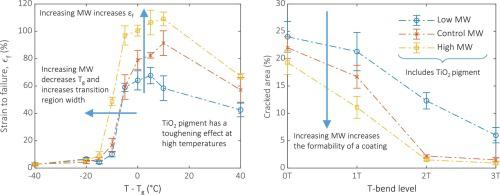当前位置:
X-MOL 学术
›
Prog. Org. Coat.
›
论文详情
Our official English website, www.x-mol.net, welcomes your
feedback! (Note: you will need to create a separate account there.)
The effect of varying molecular weight on the performance of HMMM-crosslinked polyester coatings
Progress in Organic Coatings ( IF 6.5 ) Pub Date : 2020-12-01 , DOI: 10.1016/j.porgcoat.2020.105920 Fabian S. Sorce , Tom Shields , Sonny Ngo , Chris Lowe , Ambrose C. Taylor
Progress in Organic Coatings ( IF 6.5 ) Pub Date : 2020-12-01 , DOI: 10.1016/j.porgcoat.2020.105920 Fabian S. Sorce , Tom Shields , Sonny Ngo , Chris Lowe , Ambrose C. Taylor

|
Abstract Thermosetting polyester coatings crosslinked with hexa(methoxymethyl)melamine (HMMM) are ubiquitous for the pre-painted metal sheet used in white goods and architectural cladding. The coatings are typically 20 μm thick and must have superior resistance to cracking during the forming process to maintain their excellent aesthetics and corrosion resistance. Hence, understanding their structure-property relationships is key to design durable coatings with good formability. The thermo-mechanical properties of clear and TiO2-pigmented polyester-HMMM free-films with varying number average molecular weight (MW) from Mn =1500 g/mol to 3300 g/mol and a constant crosslinker content of 20 % have been determined, and this work provides a fundamental investigation into the effects of varying the MW for the first time. Increasing the MW decreases the glass transition temperature (Tg) as the crosslink density reduces due to fewer functional chain ends. The Young’s modulus and yield stress decrease with an increase in MW at low temperatures, and the strain to failure increases around Tg. The TiO2 pigment increases the stiffness of the coatings and reduces the strain to failure around Tg, but has a toughening effect at higher temperatures. All the coatings show comparable behaviour in the Erichsen cupping test; however, increasing the MW reduces the damage during the T-bend test as the coatings are able to withstand higher applied strains. Thus controlling the MW allows a balance of properties to be achieved, as increasing the MW reduces the Tg and modulus while increasing the strain to failure and formability of the coating. Such an understanding of the structure-property relationships allows for better formulating and targeted coating design, reducing cost and increasing performance in the coil coating industry.
中文翻译:

不同分子量对HMMM交联聚酯涂料性能的影响
摘要 与六(甲氧基甲基)三聚氰胺 (HMMM) 交联的热固性聚酯涂料普遍用于白色家电和建筑覆层中使用的预涂金属板。涂层通常为 20 μm 厚,并且必须在成型过程中具有出色的抗裂性,以保持其出色的美观性和耐腐蚀性。因此,了解它们的结构-性能关系是设计具有良好成型性的耐用涂层的关键。已经确定了具有不同数均分子量 (MW) 从 Mn = 1500 g/mol 到 3300 g/mol 且恒定交联剂含量为 20% 的透明和 TiO2 着色聚酯-HMMM 游离膜的热机械性能,这项工作首次对改变 MW 的影响进行了基本调查。增加 MW 会降低玻璃化转变温度 (Tg),因为由于较少的官能链末端导致交联密度降低。杨氏模量和屈服应力在低温下随着 MW 的增加而降低,并且破坏应变在 Tg 附近增加。TiO2 颜料增加了涂层的刚度并降低了 Tg 附近失效的应变,但在较高温度下具有增韧作用。所有涂层在 Erichsen 杯突试验中都表现出类似的行为;然而,增加 MW 会减少 T 型弯曲试验期间的损坏,因为涂层能够承受更高的施加应变。因此,控制 MW 可以实现性能的平衡,因为增加 MW 会降低 Tg 和模量,同时增加涂层的失效应变和可成型性。
更新日期:2020-12-01
中文翻译:

不同分子量对HMMM交联聚酯涂料性能的影响
摘要 与六(甲氧基甲基)三聚氰胺 (HMMM) 交联的热固性聚酯涂料普遍用于白色家电和建筑覆层中使用的预涂金属板。涂层通常为 20 μm 厚,并且必须在成型过程中具有出色的抗裂性,以保持其出色的美观性和耐腐蚀性。因此,了解它们的结构-性能关系是设计具有良好成型性的耐用涂层的关键。已经确定了具有不同数均分子量 (MW) 从 Mn = 1500 g/mol 到 3300 g/mol 且恒定交联剂含量为 20% 的透明和 TiO2 着色聚酯-HMMM 游离膜的热机械性能,这项工作首次对改变 MW 的影响进行了基本调查。增加 MW 会降低玻璃化转变温度 (Tg),因为由于较少的官能链末端导致交联密度降低。杨氏模量和屈服应力在低温下随着 MW 的增加而降低,并且破坏应变在 Tg 附近增加。TiO2 颜料增加了涂层的刚度并降低了 Tg 附近失效的应变,但在较高温度下具有增韧作用。所有涂层在 Erichsen 杯突试验中都表现出类似的行为;然而,增加 MW 会减少 T 型弯曲试验期间的损坏,因为涂层能够承受更高的施加应变。因此,控制 MW 可以实现性能的平衡,因为增加 MW 会降低 Tg 和模量,同时增加涂层的失效应变和可成型性。









































 京公网安备 11010802027423号
京公网安备 11010802027423号